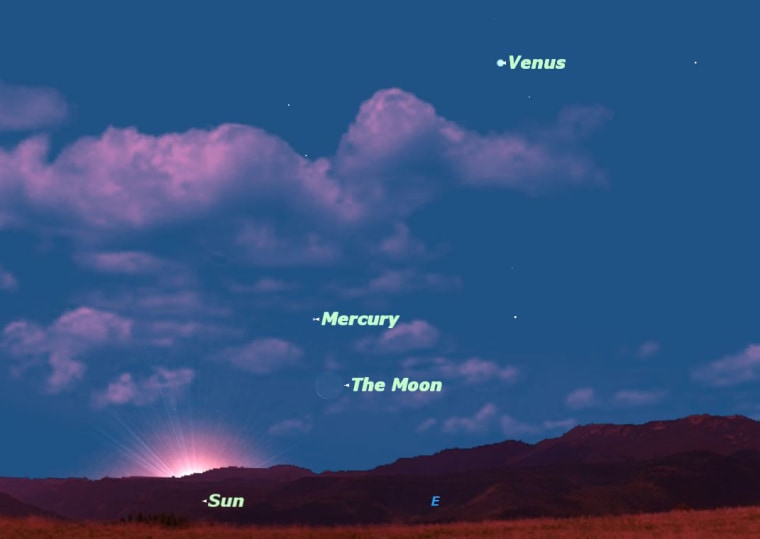Both Mercury and Venus travel in orbits closer to the sun than we do on Earth. As a result we always need to look towards the sun to see them, and the planets never wander far from our nearest star as viewed from Earth.
As the brightest object in the sky after the sun and moon, Venus is hard to miss. Ever since Venus transited the sun on June 5, it has been shining like a brilliant beacon in our morning sky. It will continue to be a “morning star” until the end of the year.
Mercury is smaller, fainter, and closer to the sun, so is much harder to see. Many skywatchers go through their entire lives without ever seeing this elusive planet. Thursday morning, Aug. 16, is one of the rare opportunities when you can catch a glimpse of Mercury.
Two things make this possible. First, Mercury is at its greatest distance from the sun. Secondly, it will be close to the thin crescent moon, which will provide a guideline to lead you to it.
In the sky map accompanying this guide, the time has been set to sunrise, but if you actually wait until sunrise it will probably be too late to see Mercury. [Planets in August Night Sky (Sky Map Gallery)]
Because Mercury is a tiny speck of light in a brightening dawn sky, there is only a narrow window of opportunity to spot it. It must be high enough above the horizon to be above the haze that usually obscures our view at low altitudes, but it must also be spotted before the sky becomes flooded with light from the sun.
The best time is about an hour to half an hour before sunrise. Most planetarium software programs will tell you the exact time of sunrise at your location, which is what you need to pin down this time. Get the time of sunrise, subtract an hour, and start watching close to the horizon.
Binoculars are a valuable aid in spotting Mercury. Focus them carefully on the moon or Venus, and then carefully sweep back and forth along the horizon just to the right of where the sun will rise. Use Venus and the moon to narrow down your search area.
Once you spot Mercury in binoculars and get your bearings on the horizon, it becomes surprisingly easy to see with your naked eye.
This is also a rare opportunity to get a sense of the structure of the inner solar system. Mercury is at its maximum westward extension from the sun. By coincidence, Venus is also just a day past its maximum westward extension. Once you’ve spotted Mercury and Venus, and have a sense of where the sun lies just below the horizon, you have an exact picture of the orbits of these two planets around the sun. In particular, you can see how much closer Mercury orbits around the sun than does Venus.
If you have a telescope, take a look at these two planets. Because of the geometry of their being at greatest elongation, both are also close to the “half moon” phase, 50 percent illuminated by the sun. In a telescope you will see that Venus is three times larger than Mercury: 24 arcseconds in diameter as opposed to 8 arcseconds.
If you miss Mercury Thursday morning, you will still have a chance to see it over the next few days, but it will be harder to find because the moon will have moved on, and will no longer serve as a guide.
Editor's note: If you snap an amazing photo Venus or Mercury that you'd like to share for a possible story or image gallery, send images and comments (including name and location) to managing editor Tariq Malik at tmalik@space.com.
This article was provided to SPACE.com by Starry Night Education, the leader in space science curriculum solutions. Follow Starry Night on Twitter .
